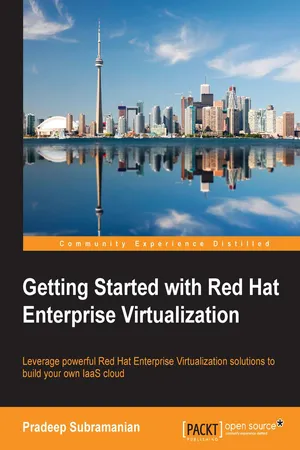![]()
Getting Started with Red Hat Enterprise Virtualization
![]()
Table of Contents
Getting Started with Red Hat Enterprise Virtualization
Credits
About the Author
About the Reviewers
www.PacktPub.com
Support files, eBooks, discount offers, and more
Why subscribe?
Free access for Packt account holders
Preface
What this book covers
What you need for this book
Red Hat Enterprise Virtualization Manager 3.3
The Red Hat Enterprise Virtualization Hypervisor host
Optional requirements
Who this book is for
Conventions
Reader feedback
Customer support
Downloading the example code
Errata
Piracy
Questions
1. An Overview of Red Hat Enterprise Virtualization
The virtualization overview
Kernel-based Virtual Machine (KVM)
Features of RHEV
Supported virtual machine operating systems
RHEV architecture
Components of RHEV
The hardware and software requirement of RHEV
Red Hat Enterprise Virtualization Manager
The Red Hat Enterprise Virtualization Hypervisor host
The Red Hat Enterprise Virtualization Manager client
Storage
Directory services (optional)
Networking and Domain Name Service
Virtual machines
Firewall Requirements
Virtualization manager firewall requirements
Virtualization host firewall requirements
Directory server firewall requirements
Remote database server firewall requirements
User accounts and groups
Summary
2. Installing RHEV Manager and Hypervisor Hosts
Environment mapping
Setting up the RHEL operating system for the manager
Registering with Red Hat Network
Installing the RHEV-Manager packages
Running the initial engine setup
Connecting to the admin and user portal 006C
RHEV reporting
Installing the RHEV history database and report server
Accessing the RHEV report portal
Deploying RHEV Hypervisor
Installing the hypervisor
Configuring the hypervisor
Summary
3. Setting Up the RHEV Virtual Infrastructure
Configuring RHEV
Data centers
Clusters
Approving hypervisor hosts
Logical networks
Adding logical networks
Storage domains
Adding a data domain to store virtual machines
Adding a data domain of other storage types
Activating the ISO domain
Populate ISO images on an ISO domain
Configuring and activating an export domain
Summary
4. Creating and Managing Virtual Machines
Virtual machines
Creating Linux virtual machines
General settings
System settings
Initial Run settings
Console settings
Host settings
High Availability settings
Resource Allocation settings
Boot Options settings
Custom Properties
Adding virtual disks
Installing Red Hat Enterprise Linux on a virtual machine
Installing guest agents and drivers on RHEL guests
Creating Windows virtual machines
Installing VirtIO drivers during the Windows installation
Guest agents and driver installation on Windows guests
Virtual machine templates
Creating a Red Hat Enterprise Linux template
Cloning a RHEL virtual machine from a template
Creating a Windows template
Virtual machine snapshots
Creating snapshots
Restoring virtual machines from the snapshot
Creating a virtual machine from the snapshot
Deleting a virtual machine snapshot
Backing up virtual machines to export disks
Exporting a virtual machine and template
Importing a virtual machine and template
Summary
5. Virtual Machine and Host High Availability
Virtual machine's live migration
Advantages of live migration
The requirements of live migration
Manual live migration
Cold migration
Cancelling migration
Virtual machine's high availability
Automatic virtual machine migration
The migration priority
Disabling the automatic virtual machine migration
The host's high availability
Manual fencing
Cluster policies
The resilience policy
The cluster policy
Summary
6. Advanced Storage and Networking Features
Shareable disks
Direct LUN mapping
Virtual disk resize
Storage live migration
VNIC QoS
Hot plugging devices
Hot plugging and removing virtual hard disks
Hot plugging in VNIC
Hot plugging virtual CPU
Summary
7. Quota and User Management
An overview of user management
Adding the IdM domain to RHEV Manager
Validating and listing added domains
Adding directory users
Authorizing users and assigning roles
Creating a new role
Introduction to Quota
Enabling Quota
Creating the Quota policy
Assigning Quota to virtual machine objects
Assigning Quota to limit resources by users
Summary
8. Managing a Virtualization Environment from the Command Line
Introduction to the CLI
Installing and setting up CLI
Basic command-line examples
Running Linux commands in a shell
Listing resources from the command-line shell
Creating and editing a virtual machine
Summary
9. Troubleshooting RHEV
RHEV Manager logs
RHEV Hypervisor hosts' logs
Guest agent and SPICE logs
The log collector utility
Maintaining an RHEV environment
The stop procedure
The start procedure
Summary
10. Setting Up iSCSI, NFS, and IdM Directory Services for RHEV
Setting up iSCSI for the data domain
Setting up NFS for the export domain
Installing and configuring Red Hat IdM
Adding users from CLI
Summary
Index
![]()
Getting Started with Red Hat Enterprise Virtualization
Copyright © 2014 Packt Publishing
All rights reserved. No part of this book may be reproduced, stored in a retrieval system, or transmitted in any form or by any means, without the prior written permission of the publisher, except in the case of brief quotations embedded in critical articles or reviews.
Every effort has been made in the preparation of this book to ensure th...
